

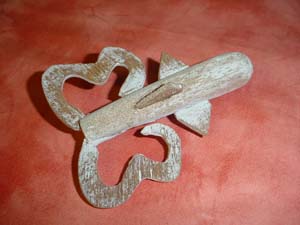
This is how I make my own softbaits
Fishing softbaits is the hot thing to do these days. Catches on softbaits are good but the life expectancy of a soft plastic lure is not all that high. You also need to take into consideration that a large-sized plastic bait is quite expensive and often it's hard to find these lures. So we will get down to business ourselves. But how, you ask? In this article I would like to explain to you how I went to work building the Baaldag plastic bait that I designed.
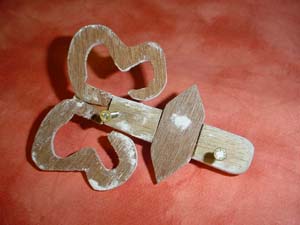
The original lure
You need an original copy of a lure to place it in the wet cyproc that you will use to make the mold. You can also use an already existing lure but the challenge of making your own model is far more rewarding. Take into consideration that making a plastic lure with a flat belly is a lot easier. To make one of these lures, you will only need one mold. You can use two molds but then you will have to melt the two halves together after you poured them seperately. When you wish to make a round, plastic bait, you can't follow the instructions included in this article.
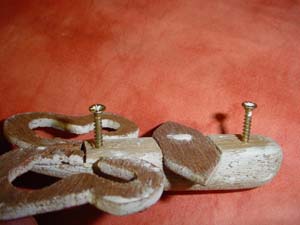
I make the body from a piece of wood. It makes little difference what type of wood you use. I will shape this piece of wood to the desired shape and I shape the small wings from a 4mm thick piece of fibreboard. These small wings will prevent the lure from spinning when you retrieve the bait. The tail is built from the same type and thickness of fibreboard. The wooden, original model doesn't have to show a lot of details. Most of the small details will vanish when you make the mold. Place two screws on the flat belly side of the lure so you will be able to hold it when you position this original, wooden copy in the wet cyproc.
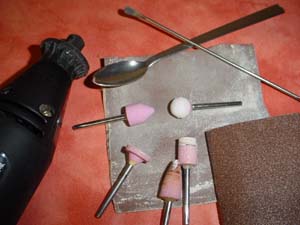
The mold
I use cyproc for my mold. Not the type sold in DIY stores but the type from a hobby shop (or the one they use to make a cast on a leg) because it has a finer structure. Mix this product with water in a tub and respect the scales. From now on you have only a few minutes before the mixture hardens. When it starts to harden, heat will be released. Then you need to press the original lure in the wet mixture holding it with its flat belly up. Now you can grab the screws to hold the lure in position. Remove the original when the mixture begins to harden. When you do this too early, the mold will collapse.
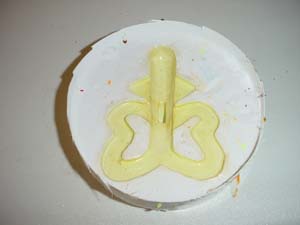
If you remove the original too late, the cyproc will be so strong that you will damage the mold when you try to remove the wooden lure. I deliberately avoid mentioning working time because it all depends on the type of cyproc and the moist level. You can now use some spates to improve the shape of the mold while the mixture has not fully hardened yet. When it has, you can use some sanding paper to sand the surface of the mold smooth. I used a Dremel multitool and its different sanding bits. When the model has been shaped to your satisfaction, you can lacquer the surface of the mold with boat lacquer. This gives the softbaits a high gloss surface.
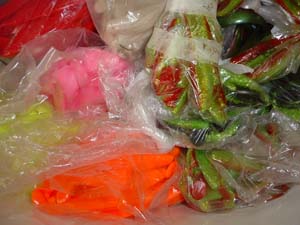
Pouring the baits
I melt plastic shad baits to pour my own baits. You can easily get these in any tackle store but the real problem with this is that you need to work on getting them cheap. Germany is a good place to get a good deal on large quantities of plastic shad baits. You can melt the plastic shads in a microwave or on an electrical stove. Pay attention to the fumes that are released when you are melting plastic because the fumes are toxic and the smell is really nasty. Make sure you air out the room where you are melting the plastic shads. One option is to melt them outdoors because then the wind will blow away the fumes. I use a ventilator. This machine sucks in the fumes in a closed room and it releases them outdoors. This type of "room" is also used for chemical experiments. It's a kind of glass box with a ventilator attached to the top. So you are positioned outside of this box but the melting goes on inside of it. I have no experience with a microwave, only with the electric stove. Use a pair of scissors to cut the shads in small pieces and put them in a stainless steel tin.
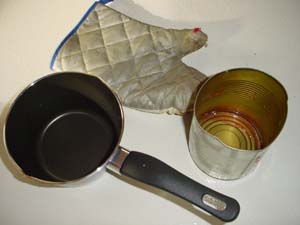
It works better with a small frying pan that has a special coating to prevent the food from burning to the bottom of the pan (like a TEFAL pan). For small quantities a tin is more than adequate. I started out that way myself. You have to keep stirring the melted plastic to make sure it doesn't burn. When the mixture is liquid you should make a V-shaped cut in the edge of the tin to be able to pour the melted plastic in the mold that has been positioned horizontally on a surface. You have to pour the mixture in one fluent motion. The best thing you can do, is to grab the tin with a pair of pliers. Pour enough melted plastic in the mold because the hot plastic will collapse a little when it starts to cool down.
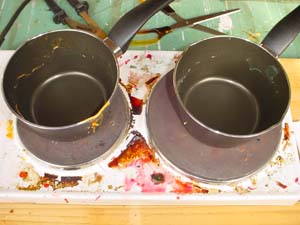 When you would like to pour a softbait that consists of multiple colors, you have to make sure that both the components are warm at the same time when they are being poured in the mold. If you don't do it this way, the second color won't be sufficiently attached or even not at all attached to the first color. When you wait a couple of minutes the softbait has cooled down sufficiently to remove it from the mold. Put the softbait in a bucket filled with cold water to allow it to harden fully. When the edges aren't shaped neatly, you can use a pair of scissors to fine-tune the edges. Add some leadweight and hooks and you are ready to test your creations.
When you would like to pour a softbait that consists of multiple colors, you have to make sure that both the components are warm at the same time when they are being poured in the mold. If you don't do it this way, the second color won't be sufficiently attached or even not at all attached to the first color. When you wait a couple of minutes the softbait has cooled down sufficiently to remove it from the mold. Put the softbait in a bucket filled with cold water to allow it to harden fully. When the edges aren't shaped neatly, you can use a pair of scissors to fine-tune the edges. Add some leadweight and hooks and you are ready to test your creations.
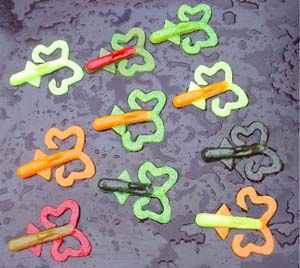 I would like to stress that melting softbaits is not without danger. The fumes can cause headaches and other physical problems. I have no idea about the long term effects on humans. So follow my instructions about melting the plastic in a ventilated area. Furthermore the melted plastic is HOT so avoid all contact! It cause burns and it is very difficult to remove it because it really adheres to your skin.
I would like to stress that melting softbaits is not without danger. The fumes can cause headaches and other physical problems. I have no idea about the long term effects on humans. So follow my instructions about melting the plastic in a ventilated area. Furthermore the melted plastic is HOT so avoid all contact! It cause burns and it is very difficult to remove it because it really adheres to your skin.
I can imagine that this article doesn't answer all your questions regarding this subject so feel free to send me an email at k.j.c.zuidema@zonnet.nl when something needs explaining. Possibly this article will be corrected.
Klaasjan.









 When you would like to pour a softbait that consists of multiple colors, you have to make sure that both the components are warm at the same time when they are being poured in the mold. If you don't do it this way, the second color won't be sufficiently attached or even not at all attached to the first color. When you wait a couple of minutes the softbait has cooled down sufficiently to remove it from the mold. Put the softbait in a bucket filled with cold water to allow it to harden fully. When the edges aren't shaped neatly, you can use a pair of scissors to fine-tune the edges. Add some leadweight and hooks and you are ready to test your creations.
When you would like to pour a softbait that consists of multiple colors, you have to make sure that both the components are warm at the same time when they are being poured in the mold. If you don't do it this way, the second color won't be sufficiently attached or even not at all attached to the first color. When you wait a couple of minutes the softbait has cooled down sufficiently to remove it from the mold. Put the softbait in a bucket filled with cold water to allow it to harden fully. When the edges aren't shaped neatly, you can use a pair of scissors to fine-tune the edges. Add some leadweight and hooks and you are ready to test your creations.
 I would like to stress that melting softbaits is not without danger. The fumes can cause headaches and other physical problems. I have no idea about the long term effects on humans. So follow my instructions about melting the plastic in a ventilated area. Furthermore the melted plastic is HOT so avoid all contact! It cause burns and it is very difficult to remove it because it really adheres to your skin.
I would like to stress that melting softbaits is not without danger. The fumes can cause headaches and other physical problems. I have no idea about the long term effects on humans. So follow my instructions about melting the plastic in a ventilated area. Furthermore the melted plastic is HOT so avoid all contact! It cause burns and it is very difficult to remove it because it really adheres to your skin.